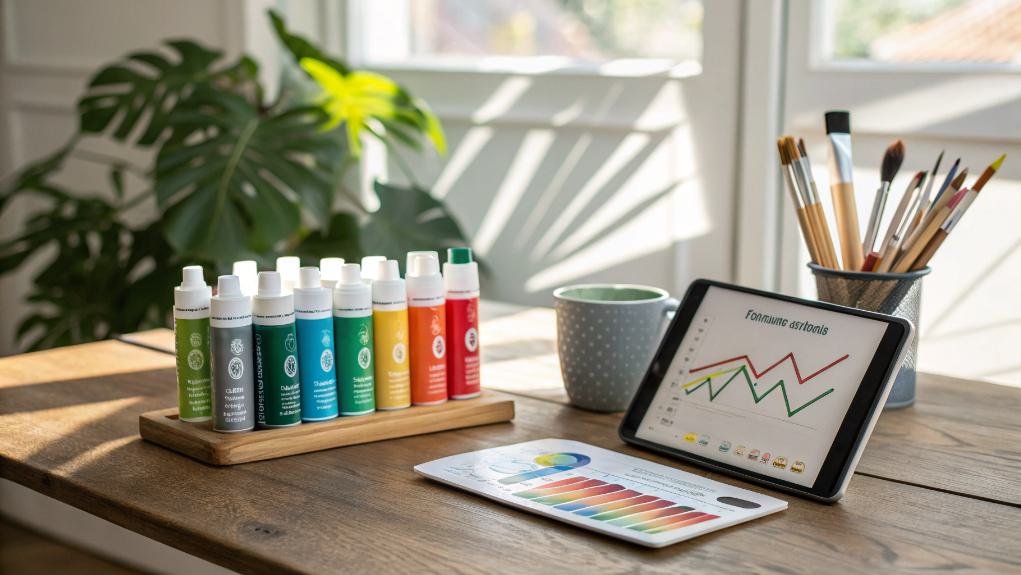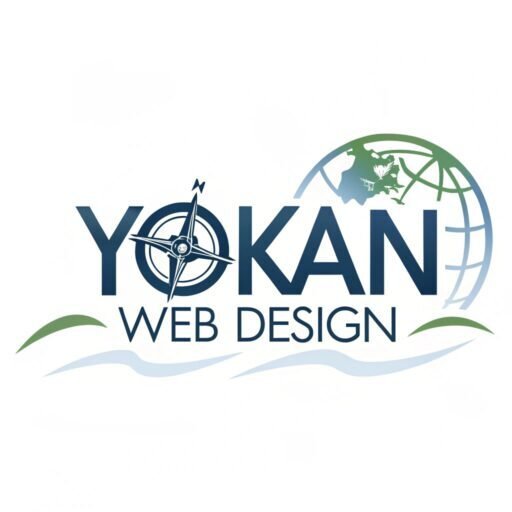To thrive in the painting business, you need to set KPIs that balance revenue growth and competitive rankings. Focus on metrics like gross profit margin and revenue per employee to gauge profitability and operational efficiency. Aim for a net profit margin of 15% or higher to guarantee financial health. Customer satisfaction is essential too; aim for scores above 80% to boost loyalty. Regularly track these KPIs with automated tools for real-time insights, adjusting strategies as needed. This strategic approach not only enhances your operational effectiveness but also sets the stage for sustainable growth and resilience in a competitive marketplace. There's much more to explore.
Key Takeaways
- Establish KPIs focusing on revenue growth rate to gauge overall performance and sales strategy effectiveness in your painting business.
- Monitor gross profit margin, aiming for 40% or higher, to ensure competitive pricing and operational efficiency.
- Evaluate customer satisfaction scores, targeting 80%+, to maintain high service quality and foster client loyalty.
- Utilize technology for real-time KPI tracking and data visualization to align business operations with strategic goals.
- Regularly review and adjust KPIs based on market research and performance to seize growth opportunities and enhance profitability.
Importance of KPIs in Painting Business

Key Performance Indicators (KPIs) are the backbone of a successful painting business, providing critical insights that drive performance and profitability.
By establishing KPI alignment with your business goals, you can effectively measure performance across various areas, including project completion rates and employee productivity. Regular tracking of these metrics not only enhances operational efficiency but also fosters improved customer satisfaction. When you continuously review KPIs, you gain a thorough view of your business health, allowing for strategic decision-making and market adaptation. Businesses monitoring KPIs are 12% more likely to meet financial goals, ensuring that your efforts translate into measurable success.
Tailoring KPIs specifically for the painting industry guarantees that you're accurately evaluating your performance, giving you a competitive edge. Ultimately, integrating KPI measurement into your processes is essential for sustainable growth and success in a dynamic market.
Revenue Metrics to Track

Tracking revenue metrics is essential for the success of your painting business, offering a precise understanding of financial health and operational efficiency.
By focusing on key indicators like gross profit margin and revenue per employee, you can gauge your effectiveness in driving profitability. Aim for a net profit margin of 15% or higher and monitor your revenue growth rate to evaluate sales strategies.
Employ revenue tracking methods like EBITDA multiples and sales multiples to assess your business's valuation. Additionally, understanding average job costs and project overhead percentages will enhance your financial forecasting, guiding your budget and pricing strategies. The importance of industry benchmarks in evaluating these metrics cannot be overstated, as they provide essential context for your performance.
Operational Efficiency Standards

To boost your painting business, mastering job management effectiveness and time optimization strategies is essential. High job completion rates and efficient project timelines not only enhance customer satisfaction but also improve profitability. Regular tracking of KPIs can significantly drive operational improvements and decision-making, leading to better overall performance.
Job Management Effectiveness
While many painting businesses focus on revenue generation, effective job management is essential for maintaining operational efficiency and profitability. By implementing robust job tracking methods and performance metrics, you can pinpoint inefficiencies and enhance your bottom line. Job costing enables you to compare actual costs against revenue, revealing cost overruns and opportunities for improvement. This process is crucial as job costing serves as a tool for understanding business operations.
| Key Metrics | Target Value |
|---|---|
| Gross Profit Percentage | ≥ 40% |
| Labor Costs as % of Revenue | < 40% |
| Production Efficiency Rate | > 85% |
| Quality Control Pass Rate | ≥ 95% |
| Employee Productivity Rate | > 75% |
Regularly reviewing these standards helps you stay competitive, ensuring your business thrives in a challenging market.
Time Optimization Strategies
Effective job management lays the groundwork for exploring time optimization strategies, which can greatly enhance your painting business's operational efficiency.
By prioritizing effective time management and project scheduling, you can guarantee that resources are allocated wisely, minimizing delays and maximizing productivity. Implementing technology to streamline operations can further enhance your efficiency by automating administrative tasks.
Utilizing advanced project management software allows you to track performance metrics in real-time, helping you to quickly identify and rectify errors.
This transparency not only boosts labor allocation but also guarantees consistent material supply, critical for timely project completion.
Aim for a job completion rate above 90% and a revenue per employee between $100,000 and $150,000 to reflect your efficiency.
Embracing these strategies will empower you to streamline operations and drive sustainable growth.
Customer Satisfaction Benchmarks

Customer satisfaction benchmarks serve as essential indicators of a painting business's overall performance and reputation. By measuring service quality through customer feedback, you can identify strengths and areas for improvement. Aim for a satisfaction score of at least 80%, with top performers reaching 85-95%. Notably, companies like Sherwin-Williams excel in customer satisfaction by achieving the highest ratings in industry studies.
Consider these key factors:
- Application quality – ease of application and coverage.
- Durability – resistance to dirt and wear.
- Price – the perceived value relative to cost.
- Variety – range of offerings and services.
Regular surveys will help you gauge customer sentiment and enhance loyalty, leading to repeat business and referrals.
Monitoring these benchmarks guarantees your painting business stays competitive and meets client expectations effectively.
Financial Health Indicators

Understanding financial health indicators is essential for your painting business's success. By focusing on revenue growth strategies and analyzing your profit margins, you can pinpoint areas for improvement and enhance your overall financial stability. These metrics not only reflect your business's current state but also guide your decisions for sustainable growth. Regular monitoring of financial statements is crucial in assessing your business's performance and making informed decisions.
Revenue Growth Strategies
While maneuvering the competitive landscape of the painting business, leveraging key financial health indicators is essential for driving revenue growth.
You need to adopt effective marketing tactics and pricing strategies, focusing on these indicators:
- Revenue Growth Rate: Track your revenue increase over time.
- Average Job Size: Monitor how much each project contributes.
- Cost Per Square Foot: Assess profitability against pricing.
- Project Completion Rate: Guarantee projects are finished on time and within budget. Consistent online strategies can also play a crucial role in enhancing your revenue by increasing client conversion rates.
Utilizing these metrics enables you to fine-tune your approach, guaranteeing you're not just chasing rankings but actively cultivating a sustainable revenue stream.
Profit Margin Analysis
In the painting business, profit margin analysis plays an essential role in determining your financial health and operational success. By calculating your gross profit margin—subtracting direct costs from revenue and dividing by revenue—you gain insight into profitability. Maintaining a 40% gross profit margin can give you a competitive advantage, enabling you to implement effective pricing strategies. Monitoring profit margin trends over time helps you identify areas for improvement and adjust your competitive pricing accordingly. For instance, if a $10,000 job yields a 50% gross profit margin, it indicates strong operational efficiency and effective cost management. Additionally, achieving high gross profit margins demonstrates your business's resilience in the market and contributes to long-term success. Ultimately, understanding and optimizing your profit margins can lead to sustainable growth and enhanced financial stability in your painting business.
Safety and Compliance Measures

Safety and compliance measures are crucial in the painting business, not only to protect workers but also to enhance your company's reputation and bottom line.
Implementing robust safety protocols can greatly reduce risks and liabilities. Here are four essential components to take into account:
- Confirm all employees wear appropriate safety equipment, like gloves and respirators.
- Conduct regular compliance training to keep your team informed about OSHA and EPA standards. Understanding the importance of proper ventilation can further ensure a safer work environment.
- Maintain proper ventilation and inspect tools daily to prevent accidents.
- Follow strict protocols for hazardous waste disposal to meet local regulations.
Strategic Planning for Success

Strategic planning is essential for the long-term success of your painting business, as it provides a clear roadmap for growth and profitability. By defining your purpose, values, and both short-term and long-term goals, you create a foundation that aligns your team.
Conducting thorough market research and competitor analysis allows you to identify gaps and opportunities for market expansion. Establishing strategic partnerships can further enhance your reach and resources.
Additionally, outlining actionable steps guarantees your team understands their roles in achieving these goals. Regularly reviewing key performance indicators (KPIs) keeps you on track, enabling you to adjust strategies as needed.
Celebrate milestones to motivate your team and reinforce a culture of success.
Technology's Role in KPI Management
While many painting businesses rely on instinct and experience to gauge performance, leveraging technology for KPI management can transform how you track and analyze success.
Here are some key benefits of technology integration:
- Automated Tracking Tools: Use software for real-time KPI monitoring and data visualization.
- KPI Dashboards: Visualize metrics and trends, enhancing operational efficiency.
- Regular Reviews: Adjust KPIs based on performance data to align with business goals.
- Data-Driven Decisions: Employ analytics to identify strengths and areas for improvement.
